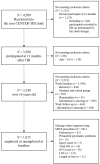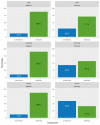Early Predictors of Employment Status One Year Post Injury in Individuals with Traumatic Brain Injury in Europe
- PMID: 32604823
- PMCID: PMC7355447
- DOI: 10.3390/jcm9062007
Early Predictors of Employment Status One Year Post Injury in Individuals with Traumatic Brain Injury in Europe
Abstract
Sustaining a traumatic brain injury (TBI) often affects the individual's ability to work, reducing employment rates post-injury across all severities of TBI. The objective of this multi-country study was to assess the most relevant early predictors of employment status in individuals after TBI at one-year post-injury in European countries. Using a prospective longitudinal non-randomized observational cohort (The Collaborative European NeuroTrauma Effectiveness Research in TBI (CENTER-TBI) project), data was collected between December 2014-2019 from 63 trauma centers in 18 European countries. The 1015 individuals who took part in this study were potential labor market participants, admitted to a hospital and enrolled within 24 h of injury with a clinical TBI diagnosis and indication for a computed tomography (CT) scan, and followed up at one year. Results from a binomial logistic regression showed that older age, status of part-time employment or unemployment at time of injury, premorbid psychiatric problems, and higher injury severity (as measured with higher Injury severity score (ISS), lower Glasgow Coma Scale (GCS), and longer length of stay (LOS) in hospital) were associated with higher unemployment probability at one-year after injury. The study strengthens evidence for age, employment at time of injury, premorbid psychiatric problems, ISS, GCS, and LOS as important predictors for employment status one-year post-TBI across Europe.
Keywords: employment; multicenter studies; outcome assessment; prospective studies; rehabilitation; traumatic brain injury.
Conflict of interest statement
The authors declare no conflict of interest. The funders had no role in the design of the study; in the collection, analyses, or interpretation of data; in the writing of the manuscript, or in the decision to publish the results.
Figures




References
-
- Maas A.I.R., Menon D.K., Adelson P.D., Andelic N., Bell M.J., Belli A., Bragge P., Brazinova A., Büki A., Chesnut R.M., et al. Traumatic brain injury: Integrated approaches to improve prevention, clinical care, and research. Lancet Neurol. 2017;16:987–1048. doi: 10.1016/S1474-4422(17)30371-X. - DOI - PubMed
LinkOut - more resources
Full Text Sources

